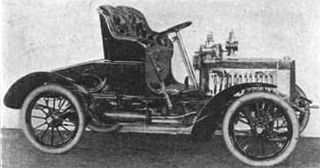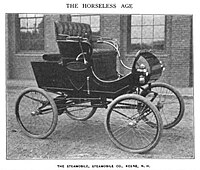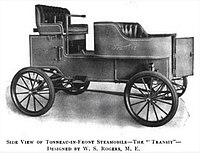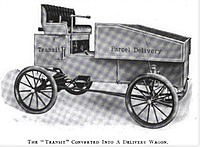
The Henry Ford Company was an automobile manufacturer active from 1901 to 1902. Named for Henry Ford, it was his second company after the Detroit Automobile Company, which had been founded in 1899. The Henry Ford Company was founded November 1901 from the reorganization of the Detroit Automobile Company. The company, much like the Detroit Automobile Company, was plagued by disputes between Ford and his investors, and Ford left in 1902. Later that year, the company was reorganized as the Cadillac Automobile Company under the suggestion of Henry M. Leland. Cadillac, whose early vehicles were identical in design to those of Ford's later Ford Motor Company except for the engine, would develop a reputation for precision engineering and was acquired by the nascent General Motors (GM) in 1909, becoming GM's luxury marque. Ford would eventually find success with the Ford Motor Company, and is considered one of the primary pioneers of the automobile.

The Brass Era is an American term for the early period of automotive manufacturing, named for the prominent brass fittings used during this time for such things as lights and radiators. It is generally considered to encompass 1896 through 1915, a time when these vehicles were often referred to as horseless carriages.

Georges Richard (1863–1922) was a French racing driver and automobile industry pioneer.
The American Chocolate later known as Walter was an American-assembled automobile. Manufactured from 1902 to 1906 by vending machine company the American Chocolate Machinery Co., in Manhattan, New York, owned by William Walter. He decided to expand his business by assembling automobiles in his factory. The cars were exhibited at the New York automobile show.

Eisenhuth Horseless Vehicle Company was a manufacturer of Brass Age automobiles who were originally based in New York City. In 1902 the company purchased the Keating Wheel and Automobile Company and established manufacturing operations in Middletown, Connecticut. During 1903, the company merged with the Graham Fox Motor Car Company, absorbing that firm and expanding operations in Middletown.

Phelps Motor Vehicle Company was a manufacturer of automobiles in Stoneham, Massachusetts, between 1903 and 1905. In 1906 it was succeeded by the Shamut Motor Company.
Smith & Mabley was an American veteran era importer of European automobiles and produced the American C. G. V. automobile in 1902, and the S & M Simplex automobile from 1904 to 1907, in New York City.

St. Louis Motor Carriage Company was a manufacturer of automobiles at 1211–13 North Vandeventer Avenue in St. Louis, Missouri, founded by George Preston Dorris and John L. French in 1898, with French taking charge of marketing and Dorris heading engineering and production. St. Louis Motor Carriage was the first of many St. Louis automakers and produced automobiles from 1899 to 1907.

Columbia was an American brand of automobiles produced by a group of companies in the United States. They included the Pope Manufacturing Company of Hartford, Connecticut, the Electric Vehicle Company, and an entity of brief existence in 1899, the Columbia Automobile Company.

Single Center Spring Buggy Company was an American carriage and automobile manufacturer based in Evansville, Indiana. The Single Center factory manufactured the Zentmobile, Zent, Windsor, Worth, Single Center, Evansville, Simplicity and Traveler automobiles from 1903 to 1910.
The Sintz Gas Engine Company was formed in about 1885 by Clark Sintz and others in Springfield, Ohio. It was a pioneering marine engine manufacturing business that expanded into other fields. After its sale in 1902 to the Michigan Yacht and Power Company, Sintz ceased to exist in 1903 as an entity.
Standard Motor Construction Company (1904-1905) was the successor to the U. S. Long Distance Automobile Company (1900-1903) of Jersey City, New Jersey. The American Veteran Era Long Distance automobile was developed into the Standard automobile in 1904.
Spaulding was used as an automobile marque by two separate companies. The Spaulding Automobile and Motor Company of Buffalo, New York built Veteran Era automobiles in 1902 and 1903. Spaulding Manufacturing Company of Grinnell, Iowa built Brass Era automobiles from 1910 to 1916.

The Smith Automobile Company of Topeka, Kansas was an early United States automobile manufacturing company which produced the Veracity, Smith, and Great Smith lines of automobiles from 1902 to 1911. They were the first automobiles made west of the Mississippi River.

The Union automobile was a vehicle manufactured by the Union Automobile Company from 1902 until 1905. It was designed by John William Lambert, who had developed the three-wheel Buckeye gasoline buggy in 1891. Over the next decade, Lambert substantially refined the vehicle, with modifications including an additional wheel, a more powerful engine, and a new transmission system. The Union Automobile Company was formed as a subsidiary of Lambert's Buckeye Manufacturing Company solely to manufacture the Union, which took its name from Union City, Indiana, the city where it was built and which endorsed its production. In total, the company built over three hundred Union automobiles, before development shifted to the Lambert automobile, the Union's successor.

The Gladiator Cycle Company, Clément-Gladiator, was a French manufacturer of bicycles, motorcycles and cars based in Le Pré-Saint-Gervais, Seine.

The Union Automobile Company was an automobile factory to manufacture the Union automobile through the Buckeye Manufacturing Company. It began manufacturing automobiles in 1902 and produced them through 1905. The company was located in Union City, Indiana. The inventor of Union automobile gasoline engine and friction drive gearless transmission was John W. Lambert. In the early part of 1905 the company moved to Anderson, Indiana. It had produced 325 automobiles before going out of business in the later part of 1905. It was replaced with a redesigned model that became the Lambert automobile.

The Searchmont Motor Company was a Veteran Era American luxury automobile manufacturer in Philadelphia, Pennsylvania from 1900 to 1903.
Ajax Motor Vehicle Company was a now-defunct American brass era electric car manufacturer established in New York City, which operated from 1901 until 1903. It produced the Ajax Electric car. Its factory was located at 220 West 36th Street, just north of the famed Macy's Department Store in Manhattan.


















